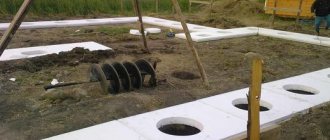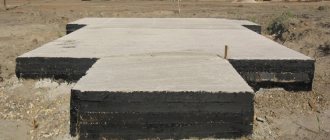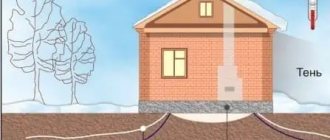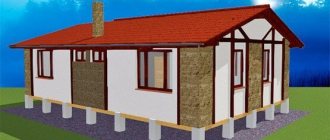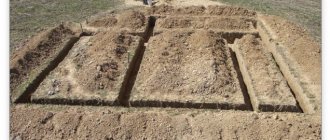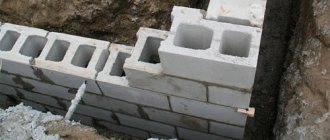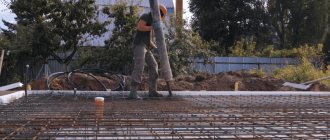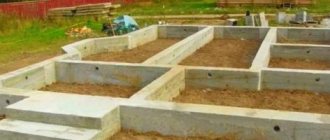How to fill the basement inside the house
Filling foundation voids
The structural design of the foundation of a house can be very different.
The most popular and universal solution is to use a strip foundation as a load-bearing base.
This makes it possible to implement a number of design features of the building, including the basement and basement.
One of the options for installing a strip foundation is to fill the voids inside the foundation with soil. The use of backfill technology makes it possible to solve a number of problems associated with the geological characteristics of the soil, as well as strengthen the foundation of the building.
Conditions of use
The cost of square meters of both land and residential premises is growing year by year. In this regard, the most rational option for the developer is to make maximum use of the usable space.
To increase the usable area of a home, a basement or basement is often installed in the foundation part. However, there are times when this option becomes impractical.
Most often this happens when the groundwater level at the construction site is high.
Before starting construction, already at the design stage of the building, a study of the type of soil is carried out. First of all, attention is paid to the load-bearing characteristics of the soil and the groundwater level.
The first factor influences the choice of foundation type, and depending on the height of the groundwater, a decision is made on the possibility of arranging a basement or ground floor.
If this indicator is low, then you can use the internal space of the foundation for auxiliary or residential premises without any problems.
Subsoil water reaches its maximum level during spring snowmelt and autumn bad weather. It is at this time that hydrological studies are recommended.
If the groundwater lies too high, above the base of the building’s foundation, the construction of a basement floor may be associated with a number of problems.
First of all, you will need to cladding the walls outside and inside, as well as finishing the basement floors with a reliable layer of waterproofing. In addition, an efficient drainage system will be required around the perimeter of the building.
All this is necessary to prevent moisture from penetrating into the basement.
Foundation tape filled with soil
Excessive dampness can cause the development of fungus, mold, putrefactive bacteria - all this leads to premature destruction of both the exterior finishing elements and the load-bearing structures of the building.
All this significantly increases the estimated cost of construction, often making the construction of basement floors economically unprofitable. It can be much easier and cheaper to completely backfill the sinuses inside the house.
This operation allows you to achieve a number of goals:
- Protection against moisture penetration into the internal foundation space. Unventilated voids in the base of a building due to high humidity can become a place for mold and mildew to form, from where they spread to the rest of the building structure.
- Strengthening the foundation walls. Backfilling the walls of the load-bearing foundation from the outside and inside makes it possible to increase their resistance to lateral deformations. This procedure also reduces the likelihood of subsidence due to the increased coefficient of friction of the side walls with the soil backfill.
- Thermal insulation. When filling the internal space of the foundation, a powerful thermal insulation cushion is created that prevents freezing of the concrete pour. This allows you to increase the service life of the foundation due to a decrease in the number of cycles of freezing and thawing during the year.
- Possibility to use the fill as a basis for pouring the subfloors of the first floor.
Pouring subfloors over fill
Material selection
Most often, backfilling of foundation cavities is carried out with the same soil that was removed when digging a construction pit - sand, clay, loam, etc.
This approach allows us to successfully resolve the issue of disposal of excavated soil with a minimum of financial costs.
Otherwise, the soil has to be transported off-site for disposal, which is associated with significant costs for transportation and loading.
However, this approach, despite all its attractiveness from a financial point of view, is not the most optimal.
This is due to the fact that the technical characteristics of the soil at a construction site do not always correspond to the conditions imposed by the relevant building regulations. Backfilling of the internal cavities of the foundation, which does not have a basement or basement, is regulated by the provisions of SNiP 3-02-01-87.
Regarding the choice of soil for internal filling, this standard pays special attention to the moisture content and density of the material.
Humidity
For backfilling, only soil that has a certain moisture content should be used. This indicator depends on the type of material and its composition.
So, if the internal cavities are filled with sand or sandy loam, then the percentage of humidity in this case should not exceed 15.
For heavier and denser soils - sand-gravel mixture, loam and clay - this figure may be slightly higher - up to 20%. In this case, the lower humidity threshold should not be less than 12%.
The presence of such restrictions is associated with the relationship between the moisture level of the material and its density.
Excessively dry soil will be crumbly and loose, difficult to compact.
Too wet material can become a source of increased dampness inside the foundation with all the ensuing negative consequences.
Soil dumps around the construction pit
Density
The soil density indicator also largely affects the quality of the internal filling of voids at the base of the building.
The less dense it is, the less protective properties it has: such backfill is less resistant to the penetration of groundwater and imparts less stability to the load-bearing structures of the foundation.
According to SNiP, the density of backfill soil must be at least 90 - 95% of the original density of untouched soil at the construction site.
In reality, such an indicator can only be achieved when using heavy soil - a sand-gravel mixture, clay and loam, or with careful, layer-by-layer compaction of sandy soil fill.
For backfilling, it is recommended to use not quarry construction or washed river sand, but ordinary sand extracted from under the soil.
It contains tiny inclusions of clay and other binding elements, which allows it to become denser over time, forming bonds between its individual particles.
Backfill technology
The entire backfilling process must be carried out in full accordance with the construction technologies described in SNiP 3-02-01-87. All work is divided into the following stages.
Drying and moistening the soil
Before you begin filling the internal voids of the foundation, you should analyze the soil for moisture.
To do this, samples are selected and sent to specialized laboratories, which, based on research, issue a conclusion about whether the material is suitable for filling, or whether it needs to be brought to condition - dried or, conversely, moistened.
When do you need a pillow under the foundation?
Despite the fact that the need for a sand cushion is rarely questioned, it turns out that it is not always necessary, and in some cases it will even be harmful.
The size of such voids is different, and when the foundation is loaded, shrinkage will occur, and it will be different for each block. Because of this, the blocks may move apart.
To prevent this from happening, you really need to make a sand cushion under such foundations: it will fill all the unevenness and evenly distribute the weight of each block.
The sand cushion evenly distributes the weight of the foundation.
By the way! It will be interesting to know: Floor on a pile foundation in a frame house
Concrete fills all uneven ground.
To protect against moisture, it is more advisable to use either additives in concrete that increase its moisture resistance, or waterproofing the foundation.
How to fill the foundation inside: choice of material
At the beginning of construction, land owners are interested in the question of arranging the foundation. Does it need to be backfilled from the inside, what materials are used to carry out the work, and what influences the choice of bulk materials.
When performing work on a pile foundation, it is necessary to take into account secondary features.
In order to finally decide on the selection of material and the thickness of the fill, you should find out at what level the groundwater is located, how much the soil can subsidence and the financial condition of the owner.
Regardless of the reasons listed above, filling the foundation is simply necessary. With its help, the service life of the room without causing damage is established.
It’s also a good idea to think about what is more profitable financially:
- backfilling for the foundation when using bulk materials;
- built basement with ventilation and high-quality thermal insulation of the flooring.
What effect does groundwater have on backfilling?
Before filling the foundation inside, you need to make sure that the cement has hardened and gained strength. Concrete hardens completely only after two weeks of exposure.
What negatively affects the structure? The first source is the spring flood. Ground water begins to rise, which causes swelling of the soil, and there is a danger of squeezing out the foundation.
After such processes, a lot of effort and labor is required to restore the house.
Clay, swampy, and peaty soil types are most susceptible to swelling. If a house is being built on a similar site, the foundation ditch is dug below the frost line.
To fill the trench internally, sand is used to fill the third part of the ditch. This is the minimum. You can also use a mixture of gravel and crushed stone, the ratio of which is 1:1.
If the groundwater is at a depth of two meters, eighty centimeters is enough to deepen the pit.
To ensure that the soil is well compacted, it is first watered with water and then compacted. In a similar way, they get rid of the emptiness present in the earth. Then there is a noticeable decrease in soil moisture. Otherwise, if the groundwater level reaches less than fifty centimeters of the surface, the trench must be dug below the distance at which freezing occurs.
How is soil subsidence determined?
Porous soil can be reduced. Therefore, a basement built on such soil may sag. It can be observed if the soil needs to be moistened. How to determine subsidence? First of all, a hole is dug.
Then it is covered with the same soil and watered with water. If there is not enough soil when filling the hole, this indicates that the soil has high shrinkage. To avoid this, the soil is washed with water and compacted.
In this regard, the risk of failure is reduced and the level of drawdown is reduced. When performing internal backfill, it is a good idea to immediately insulate the foundation blind area over the entire part.
The width must be at least eighty centimeters and there must be a slope from the building. The blind area is performed using geotextiles. It prevents the structure from ingress of melt water and precipitation.
Preparatory work for arranging the foundation begins with removing the top layer of soil. In this case, the area of the foundation and blind area is taken into account. The removed land is suitable for gardening resources, because it is very fertile.
Materials used for internal backfill
An excavator is most often used to dig a hole for the foundation. The construction project is the main document. Therefore, when digging a recess, checking with it is necessary. It has calculations based on the volume of excavated soil.
The pit should first be sprinkled with sand, the thickness of which should be no more than fifteen centimeters. The sand coating is well leveled and compacted.
In order not to make a mistake in choosing the best way to fill the internal foundation, special attention should be paid to the type of soil. Construction soils are divided into the following types:
- black soil, which is not used for backfilling inside the foundation;
- loam;
- rocky soil;
- clay;
- crushed stone
Pillow under the foundation
Soil cannot replace the bedding under the foundation. He himself is a factor, contact with which negatively affects the structure, especially with regard to seasonal movements. Thanks to the presence of a cushion placed under the foundation, the following is ensured:
It is impossible to do without good and high-quality bedding. The main thing is to choose the right material and follow the basic rules for constructing this bulk foundation for the foundation.
Nuances of arrangement
The bedding must be well leveled and compacted, and have the correct dimensions. The width is made larger than the fundamental sole. Height is a variable value. It is influenced by the following factors:
- ground water level;
- permanent and temporary loads;
- soil freezing depth;
- geological conditions.
Weak or unsuitable soils are often replaced with a cushion. The bottom of the excavation being formed is usually lined with geotextiles. It prevents the embankment from being washed out or flooded if it is made of coarse sand.
By the way! It will be interesting to know: Foundation for a one-story house made of aerated concrete
Dependence of the type of foundation and material for the pillow
The base has a direct impact on the choice of bedding. In private housing construction, as a rule, three main types of foundations are used:
- pile;
- tape;
- prefabricated tape.
It is recommended to install piles not on sand, but on crushed stone substrate. This is due to the fact that the latter has higher strength, which made crushed stone more preferable when arranging this type of base.
How to fill the foundation inside
How and with what to fill the foundation inside a house
: June 30, 2015
2,787 views
Preface.
When building a house where the basement is not planned to be used, many developers ask themselves the following questions: Is it necessary to fill the foundation inside? How to fill the space inside the foundation? How to fill the pile foundation inside? We will try to answer these questions in this article, consider what bulk materials can be used for these purposes and show a video of how to fill the foundation inside under a screed.
Before making a decision on the choice of material and fill level, you should pay attention to the groundwater level in your area and the degree of subsidence of the soil on it. It's also worth thinking things through.
Calculate what will be cheaper - fill the basement of the house with your own hands from the inside with lime, sand or other material, or build a ventilated basement and make high-quality insulation of the floor in a wooden house from below.
An example of backfilling a foundation for a floor screed
After receiving permission to build a house, the administration divides the site and begins excavation work.
The issue of excavation work should be taken very seriously, since the strength of the future structure depends on the completion of this stage.
The design and depth of the foundation depends on the geology of the site: the depth of soil freezing, the groundwater level.
What is affected by the depth of groundwater?
You should backfill the foundation inside the building yourself after the cement has completely hardened.
Spring floods, which significantly raise groundwater to the surface, pose a great danger to buildings.
As a result, the soil swells, creating pressure in the soil, which literally pushes the foundation upward as the upper layers of the soil thaw.
Buckling is observed in clayey, peaty and swampy soils. Pits and trenches for strip foundations should be dug below the frost depth in your region.
The internal space of the trenches should be filled with sand by a third - sands and loams bulge less.
If the groundwater in your area is at a depth of less than 2 meters, then the pits are made up to 80 cm deep.
To compact the soil, it is compacted and watered. At the same time, the soil is significantly compacted, all voids are removed, and the soil becomes less moisture-absorbing.
If the groundwater in the area is above 0.5 meters, the internal space of the trenches should be dug below the depth of soil freezing.
Next, we’ll talk about how to determine soil subsidence when laying a foundation.
Determination of soil subsidence at the site
Pouring the soil significantly compacts it
The porous soil inside the base shrinks when moistened, which causes damage to the structure.
To determine the subsidence of the soil, you need to dig a hole, fill it back with soil and thoroughly spill it with water.
If there is not enough soil to completely fill the dug hole, then the soil is considered subsidence. If you determine that the soil on the site is subsiding, then it is spilled with water and compacted.
The construction and internal backfilling of the strip foundation plinth must be done with an insulated blind area around the house. Must be at least 80 cm and with a slope from the structure.
The blind area must be constructed using geotextiles to drain melt water and precipitation from the building.
Geotextiles have technical characteristics such that they prevent soil mixing.
Before you start digging trenches for the foundation, you need to remove the top fertile soil layer on the site, including the blind area and basement of the house.
The fertile layer can be used for a vegetable garden, and the resulting space should be filled with soil from the foundation pit and cellar, since it does not contain organic matter, plant roots and is safe for all structures. If sand is not available, it should be ordered.
Materials for filling the foundation from the inside
Filling and compacting sand in the basement of a house
The volume of soil removed from the pit must correspond to the design. Usually the foundation pit is filled with sand no more than 15 cm to the design mark.
The sand is leveled and thoroughly compacted.
In construction, soils are divided into chernozems (they are not used for backfilling inside the basement), clays and loams, soils with admixtures of rocks and rocky soils.
The best option for ensuring waterproofing and resistance of soil to loads is loam or clay. Clay is used without additives or impurities that could damage the waterproofing.
Clay should be poured inside the strip foundation up to 300 mm with high-quality compaction to eliminate air pockets.
You cannot use sand and gravel mixture to fill a pile foundation with your own hands.
You can fill the area inside the base not only with clay, but also with sand or crushed stone, which do not change their properties under the influence of water.
When using all materials, careful compaction is required. When using sand, it is additionally shed with water to compact it.
Backfilling is carried out along the entire perimeter in a uniform layer to eliminate different lateral pressure on the foundation.
How to properly fill the foundation from the outside
This question is also very often of interest to builders. In the same way as in the previous case, it is best to use the soil that was dug out during the construction of the strip foundation. The backfill itself takes place in stages; at each stage, a new layer up to 30 centimeters deep is laid.
Completely protect the soil from foreign fragments getting into it. This is especially true for organic compounds that can trigger the process of decay. It can disrupt the uniformity of the entire structure as a result of pressure on the base of the house, which will lead to its rapid failure, loss of required qualities and, ultimately, destruction.
While filling the foundation with soil, constantly monitor the condition of the blind area surrounding the structure. The blind area drains water from the walls of the house. When filling the foundation, it should not change, bend or sag. The blind area is mated to the base at a certain angle, which determines its maximum strength, durability and efficiency.
How and with what to fill the foundation inside a house
Preface.
When building a house where the basement is not planned to be used, many developers ask themselves the following questions: Is it necessary to fill the foundation inside? How to fill the space inside the foundation? How to fill the pile foundation inside? We will try to answer these questions in this article, consider what bulk materials can be used for these purposes and show a video of how to fill the foundation inside under a screed.
Before making a decision on the choice of material and fill level, you should pay attention to the groundwater level in your area and the degree of subsidence of the soil on it. It's also worth thinking things through.
Calculate what will be cheaper - fill the basement of the house with your own hands from the inside with lime, sand or other material, or build a ventilated basement and make high-quality insulation of the floor in a wooden house from below.
An example of backfilling a foundation for a floor screed
After receiving permission to build a house, the administration divides the site and begins excavation work.
The issue of excavation work should be taken very seriously, since the strength of the future structure depends on the completion of this stage.
The design and depth of the foundation depends on the geology of the site: the depth of soil freezing, the groundwater level.
Technology of backfilling the foundation inside
After the foundation is poured with concrete, you should wait a couple of weeks. It takes time and good weather conditions for the concrete to harden and become dense. Then the base of the house is erected, and after that the backfill work can be carried out. The soil that is dug from the pit is usually used. During the period of pouring concrete blocks, it should be protected from foreign impurities that may begin to rot inside the foundation. To do this, the soil is covered with an awning or plastic film.
How and with what to fill the foundation inside a house ⋆ Proraboff.rf
The question of how important it is to backfill the foundation from the inside confronts many home owners. In addition, they need to determine exactly what material to fill the free space with.
If the foundation is piled, additional specifics must be taken into account. It is worth figuring out what bulk materials to use for such work and how to organize it.
Before choosing any specific material and determining the thickness of the fill, you need to know the groundwater level characteristic of the site.
Also, the work on backfilling the foundation is affected by soil subsidence.
The owner must also make a choice based on what financial capabilities he has, since backfilling methods vary significantly in cost.
Be that as it may, filling the foundation from the inside is incredibly important. It determines how long the house can last without developing defects. Backfill also affects the level of thermal insulation, which affects heating costs.
What affects the depth of groundwater?
You can start backfilling the foundation yourself only after the cement has completely hardened. Spring floods can have a particularly negative impact on construction.
During this process, the soil outlets rise to the surface, which leads to heaving of the soil and the risk of squeezing out the foundation.
If the foundation is squeezed out, it will be very difficult and expensive to restore the house.
Most often, swelling occurs on clay, swampy and peat soil types.
If a house is being built on such a site, the trench for the strip foundation must be dug lower than the frost line. The inside of the trench is covered with sand by at least a third.
When the depth of groundwater is no more than 2 meters, it is enough to dig a pit to a depth of 80 cm or less.
To compact the soil, it is watered and compacted. Due to such actions, it is possible to get rid of voids that may be present in the ground.
In addition, the moisture capacity of the soil is noticeably reduced.
In cases where groundwater is located closer than 50 cm to the surface, it is very important to dig a trench for the foundation below the level where freezing occurs.
Filling the foundation is an important stage of construction
Now it should be clear how important the filling of the foundation is. But do not forget that other measures to increase its waterproofing are also important.
An owner who wants to better protect his home can additionally arrange drainage, lay waterproofing of the base, and form a blind area around the perimeter.
Then the result will be the most successful.
Source: https://xn--80ac1bcbgb9aa.xn--p1ai/kak-i-chem-zasyipat-fundament-vnutri-doma/
How and with what to fill the foundation inside a house - The builder can do everything
How and with what to fill the foundation inside a house
The question of how important it is to backfill the foundation from the inside confronts many home owners. In addition, they need to determine exactly what material to fill the free space with.
If the foundation is piled, additional specifics must be taken into account. It is worth figuring out what bulk materials to use for such work and how to organize it.
Before choosing any specific material and determining the thickness of the fill, you need to know the groundwater level characteristic of the site.
Also, the work on backfilling the foundation is affected by soil subsidence.
The owner must also make a choice based on what financial capabilities he has, since backfilling methods vary significantly in cost.
Be that as it may, filling the foundation from the inside is incredibly important. It determines how long the house can last without developing defects. Backfill also affects the level of thermal insulation, which affects heating costs.

